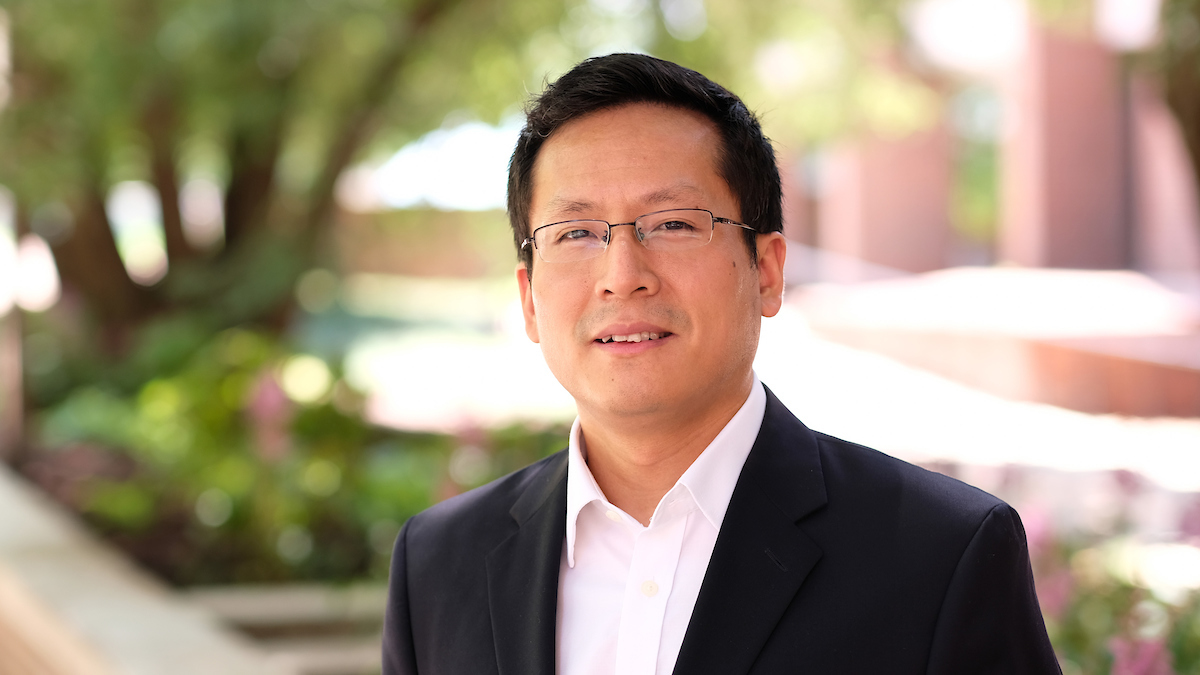
Jianli Pan, assistant professor of computer science, last year led efforts to secure three grants totaling $503,651 to help build a lab to foster students’ skill development in cybersecurity and support his own research related to edge cloud computing and Internet of Things. (Photos by August Jennewein)
Jianli Pan’s been busier than normal this summer coordinating the activities of his expanded research team at the University of Missouri–St. Louis.
The group has grown to include one doctoral student, one postdoctoral fellow and two undergraduates with assistance from a pair of visiting scholars, all helping support the assistant professor of computer science’s work in edge cloud computing, Internet of Things and cybersecurity.
They are the most tangible signs of Pan’s success over the past year, which saw him secure three grants totaling $503,651.
He served as primary investigator on a NASA grant related to resource provisioning in an edge cloud for IoT applications and a National Security Agency grant on dynamic resource provisioning methods. He also was co-primary investigator with two other faculty members from information systems and computer science on the largest award – an NSA grant of $294,519 that allowed them to develop a lab in Express Scripts Hall to help foster students’ skill development in cybersecurity.

JIanli Pan (center) accepted the Junior Faculty Investigator of the Year Award from Chris Spilling (at left), vice provost for graduate studies and research, and Chancellor Tom George at the 2018 Research & Innovation Reception in May at the Millennium Student Center.
Pan didn’t need further validation, but he received it anyway in May when the Office of Research Administration honored him as the Junior Faculty Investigator of the Year at the 2018 Research & Innovation Reception in the Millennium Student Center.
“It was a surprise, but I’m kind of happy that I got the recognition,” Pan said. “It’s definitely an honor and further motivation for me to work harder.”
Pan is set to begin his fifth year at UMSL. He joined the faculty in 2014 after earning a PhD from Washington University in St. Louis.
His doctoral work centered on internet architecture and mobile networks, but in the ever-changing world of technology, he’s had to shift his research in a new direction.
“The research we have done in PhD work is already done,” Pan said. “Internet architecture – it’s done. The core network is pretty much there. Not much new innovations will happen there, so we needed to find a new avenue, a new opportunity.”
His PhD adviser, Raj Jain, the Barbara J. and Jerome R. Cox Jr. Professor of Computer Science and Engineering at Washington University, gave Pan some good advice before he came to UMSL on how to plot his next course.
“What he said is to do what the world needs most,” Pan said. “I feel that’s been very beneficial for me, and it will benefit me for a whole lifetime.
“At that time, I believed edge computing was what the world needs. Internet of things is what the world needs next.”
Edge computing aims to shift control of computing applications and data processing away from central clouds to more remote spaces of the internet, closer to where people are. And it creates greater potential for the Internet of Things.
As Raj Talluri, the senior vice president and general manager of the mobile business unit at Micron, wrote last fall in Network World, “edge computing provides new possibilities in IoT applications, particularly for those relying on machine learning for tasks such as object detection, face recognition, language processing and obstacle avoidance.”
Pan has built a testbed to conduct research on edge cloud capabilities. A series of IoT devices have been connected to Pan’s testbed, and he and his team have integrated blockchain and smart contract capabilities for purposes of security resource allocation.
Details of his recent work can be found in a 2018 paper titled “EdgeChain: An Edge-IoT Framework and Prototype Based on Blockchain and Smart Contracts”, and a 2016 paper for the 23rd International Conference on Telecommunications titled “HomeCloud: An Edge Cloud Framework and Testbed for New Application Delivery.”
In the past few months, UMSL filed two provisional patents related to edge-IoT security technology with Pan as the lead inventor.
“I don’t have too big discoveries,” he said. “I’m taking steps forward. When I joined UMSL, edge computing was an emerging area. Definitely, a lot of things were missing.”
Pan is happy to be doing work that could lead to future progress. He chose to come to the United States from his home in China because he believed it would bring him closer to the most advanced technology in the world.
He’d been working in telecommunications after earning a bachelor’s degree from Nanjing University of Posts and Telecommunications and a master’s in information engineering from Beijing University of Posts and Telecommunications. But he started looking outside China for opportunities to do doctoral research, and Washington University offered him a scholarship.
Pan, who grew up in the Jiangxi province in south China, hadn’t necessarily planned on staying in the United States after completing his PhD, but he gained a fondness for American culture in general and life in St. Louis specifically. He was thrilled to get the opportunity he did at UMSL.
Being in academia has given him a chance to share his knowledge with students, and it’s also afforded him the freedom to guide his own research.
He’s not content to rest on his early career success.
“I’m still on the way with a lot of things to do,” he said. “To build a team is one thing, but to sustain it takes a lot of effort, especially in the United States. As faculty members, you have to fight very hard fighting for the kind of funding to pay for these students, so there’s a lot of stress for sure, but I’m working on it. Hopefully, I can keep growing, doing more research, generate a broader impact, whatever I can do. It’s my job.”














